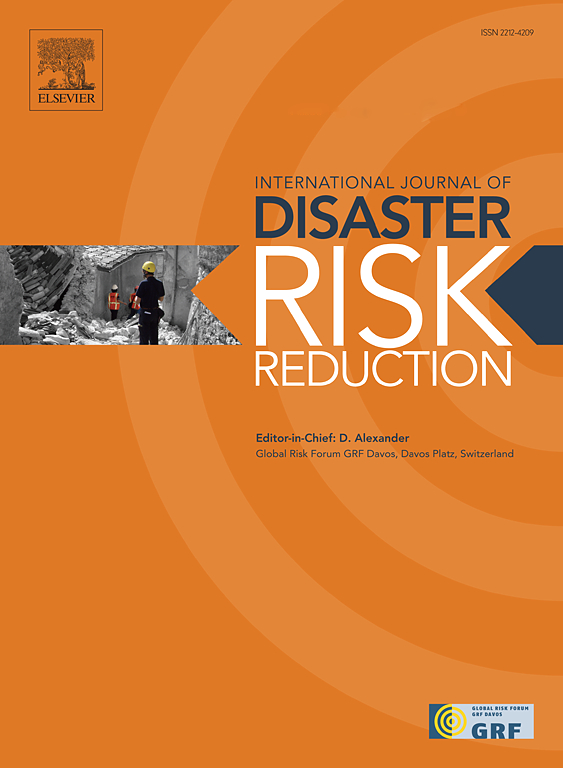Seismic assessment of non-engineered incrementally constructed unreinforced masonry infilled RC frames considering material variability
IF 4.5
1区 地球科学
Q1 GEOSCIENCES, MULTIDISCIPLINARY
International journal of disaster risk reduction
Pub Date : 2025-07-14
DOI:10.1016/j.ijdrr.2025.105703
引用次数: 0
Abstract
In many low
and middle-income countries, over half of the buildings are non-engineered structures, often including unreinforced masonry (URM) infilled with reinforced concrete (RC) frames, which often have poor seismic detailing. These buildings are typically built incrementally, leading to variations in structural systems and material quality, which result in poor seismic behavior. This study investigates the seismic performance of these buildings through a case study of a building incrementally constructed in two stages in Colombia's Sabana Centro region. The structure's system and building materials were identified through field observations. Based on these observations, representative models were developed for each construction stage. Material variability was accounted for through Latin Hypercube Sampling, using local material data to develop 150 models for each construction stage. Nonlinear dynamic analysis was performed using OpenSeesPy with FEMA P695 seismic records. Fragility curves detailing four damage states (slight, moderate, extensive, and collapse) were analyzed for damage probabilities and expected losses. Fragility curves, including uncertainties in material properties, were also evaluated, and the impact on seismic fragility using mortar and chicken wire mesh as a retrofitting technique was analyzed. Results showed that the collapse probability at the Maximum Considered Earthquake (MCE) is 42 % for the first stage and increases to 56 % for the second. Material properties strongly influence these probabilities, ranging from 32 % to 50 % for the first stage and 55 %–68 % for the second. Expected losses exceeded 50 % for both stages. Retrofitting significantly reduced the collapse probability, from 47 % to 5 % at the MCE level.
考虑材料变异性的非工程增量建造无加筋砌体填充RC框架抗震评估
在许多低收入和中等收入国家,超过一半的建筑是非工程结构,通常包括填充钢筋混凝土(RC)框架的无加固砌体(URM),其抗震细节通常较差。这些建筑通常是逐步建造的,导致结构系统和材料质量的变化,导致抗震性能差。本研究通过对哥伦比亚萨巴纳Centro地区分两个阶段逐步建造的建筑进行案例研究,调查了这些建筑的抗震性能。通过实地观察,确定了结构体系和建筑材料。基于这些观察,为每个施工阶段开发了具有代表性的模型。材料的可变性通过拉丁超立方体采样来解释,使用当地材料数据为每个施工阶段开发150个模型。利用OpenSeesPy和FEMA P695地震记录进行非线性动力分析。详细分析了四种破坏状态(轻度、中度、广泛和崩溃)的脆弱性曲线,以分析破坏概率和预期损失。还评估了脆性曲线,包括材料特性的不确定性,并分析了砂浆和铁丝网作为加固技术对地震易损性的影响。结果表明,在最大考虑地震(MCE)下,第一阶段的倒塌概率为42%,第二阶段的倒塌概率增加到56%。材料性质对这些概率有很大影响,第一阶段为32%至50%,第二阶段为55%至68%。预计这两个阶段的损失都超过50%。在MCE水平上,改造显著降低了倒塌概率,从47%降至5%。
本文章由计算机程序翻译,如有差异,请以英文原文为准。
求助全文
约1分钟内获得全文
求助全文
来源期刊

International journal of disaster risk reduction
GEOSCIENCES, MULTIDISCIPLINARYMETEOROLOGY-METEOROLOGY & ATMOSPHERIC SCIENCES
CiteScore
8.70
自引率
18.00%
发文量
688
审稿时长
79 days
期刊介绍:
The International Journal of Disaster Risk Reduction (IJDRR) is the journal for researchers, policymakers and practitioners across diverse disciplines: earth sciences and their implications; environmental sciences; engineering; urban studies; geography; and the social sciences. IJDRR publishes fundamental and applied research, critical reviews, policy papers and case studies with a particular focus on multi-disciplinary research that aims to reduce the impact of natural, technological, social and intentional disasters. IJDRR stimulates exchange of ideas and knowledge transfer on disaster research, mitigation, adaptation, prevention and risk reduction at all geographical scales: local, national and international.
Key topics:-
-multifaceted disaster and cascading disasters
-the development of disaster risk reduction strategies and techniques
-discussion and development of effective warning and educational systems for risk management at all levels
-disasters associated with climate change
-vulnerability analysis and vulnerability trends
-emerging risks
-resilience against disasters.
The journal particularly encourages papers that approach risk from a multi-disciplinary perspective.
 求助内容:
求助内容: 应助结果提醒方式:
应助结果提醒方式:


